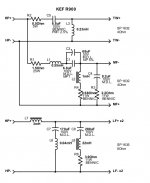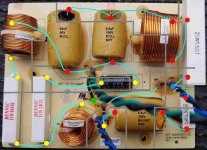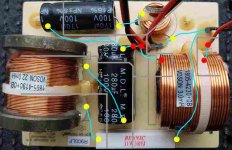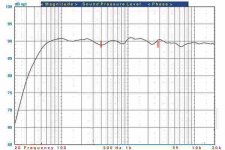Hi folks  ,
,
I would like improve the sound of the my KEF R900 speakers by upgrading its crossover parts, and am thus looking for suggestions, advices, feed-back...
You will find attached my pictures of its crossover (world premiere !).
Thanks a lot .
.
Douede
I would like improve the sound of the my KEF R900 speakers by upgrading its crossover parts, and am thus looking for suggestions, advices, feed-back...
You will find attached my pictures of its crossover (world premiere !).
Thanks a lot
 .
.Douede
Attachments
Last edited:
Only thing that would bring some improvement in their crossover would be upgrade of 3mH coil in woofer section. You should upgrade to air-coil but try to keep Rdc the same - it is somewhat highish.
Bypass those elcos with some small foil caps and that would be it. Everything other than complete redesign would be a waste of time and money.
Bypass those elcos with some small foil caps and that would be it. Everything other than complete redesign would be a waste of time and money.
Last edited:
These are fine speakers and upgrading the caps would be well worthwhile.
The difference between electrolitics and even modest caps will be noticeable. Something like Ansar Supersound caps would work nicely. You'd need to replace the boards, as they won't be big enough for these caps. The only real issue you face is the size of some of the caps. It may well prove too expensive (and space eating) to replace them with non electrolitics - a bypass cap may be your only option.
The inductors can be replaced with air cored, especially the tweeter ones. The others will be ok as long as you don't push the speakers too hard.
Resistors can be left as is - upgrades are expensive and offer minimal improvements.
The difference between electrolitics and even modest caps will be noticeable. Something like Ansar Supersound caps would work nicely. You'd need to replace the boards, as they won't be big enough for these caps. The only real issue you face is the size of some of the caps. It may well prove too expensive (and space eating) to replace them with non electrolitics - a bypass cap may be your only option.
The inductors can be replaced with air cored, especially the tweeter ones. The others will be ok as long as you don't push the speakers too hard.
Resistors can be left as is - upgrades are expensive and offer minimal improvements.
Zuhl, thanks for your answer.
I am not affraid having to move parts, solder them directly to each other, put them on another board, even put the boards out of the speaker enclosure.
I am not affraid having to move parts, solder them directly to each other, put them on another board, even put the boards out of the speaker enclosure.
I see now that there is elco series to midrange. Upgrade at that place to foil cap would also be ok. But again, i wouldn't go wild with Mundorfs or Duelunds. Kef dual concentrics are great drivers but with their factory crossovers are firmly positioned in a certain class of sound. Changes in sound throwing high price xover components at it, while maybe evident, aren't that large to make it worth the hassle.
And don't expect to hear large differences if you change elcos on woofer crossover to foil caps. Both elcos (170uF and 280uF) are used in such a manner that it will not make significant difference but will cost a small fortune.
And don't expect to hear large differences if you change elcos on woofer crossover to foil caps. Both elcos (170uF and 280uF) are used in such a manner that it will not make significant difference but will cost a small fortune.
Last edited:
.../...
What is it about the speakers that's lacking at the moment?
Chris
How i would like to improve the sound ? :
- General: More transparency and breathing (less enclosed/dark).
- HF: Less plastic, but still without becoming harsh (rich HF music).
- MF: More open/fluid, but still without becoming messy (rich MF music)
- LF: More "savage", quick, slam, vibrant... (less round/slow/heavy, "british"...).
To sum up, more transparent and neutral sound, but still never becoming harsh (when playing pop/rock music), which is one of the R900's sound characteristic.
I upgraded the capacitors in my Kef LS50 and it made a difference, even though the capacitors were all already film capacitors. Applying digital EQ for a flat response made an even bigger difference (as expected).
Here in the R900, the response is already pretty flat, but the electrolytic capacitors and low-grade film capacitors need to go. The inductors look to be good quality already, so I would leave them alone.
Here in the R900, the response is already pretty flat, but the electrolytic capacitors and low-grade film capacitors need to go. The inductors look to be good quality already, so I would leave them alone.
How i would like to improve the sound ? :
- General: More transparency and breathing (less enclosed/dark).
- HF: Less plastic, but still without becoming harsh (rich HF music).
- MF: More open/fluid, but still without becoming messy (rich MF music)
- LF: More "savage", quick, slam, vibrant... (less round/slow/heavy, "british"...).
To sum up, more transparent and neutral sound, but still never becoming harsh (when playing pop/rock music), which is one of the R900's sound characteristic.
Bare in mind that Kef loudspeakers, regarding this new technology they are using now in all their 3 way speakers, have a certain sound signature. I've been thinking about why would that be the case and what is different in Kef's drivers in regard to other manufacturers and drew few conclusions for myself but since i don't really know if i'm right, i'm reluctant to share it. Anyway, be very careful when trying to find a cure for something that may well be the sound of the drivers used and that can not be changed principally but only slightly.
From my limited experience with R series (R300 in particular) these would be my general impressions on how it sounds.
-R300 with factory crossovers are somewhat interesting at start but when the first impressions settle they become fatiguing. Very bad balance and boomy bass, treble is off and so on and so forth. R300 measures much worse, at least on axis, than R900.
-With redesigned crossovers, when everything is made to measure smooth on and off axis, they become transparent. Tweeter is one of the best that can be heard in my opinion - easily betters the one in Kii3. Upper midrange is simply great and open/vibrant in a best possible sense. It draws you into listening for long periods of time. There is nothing laid back about its sound but it never sounds fatiguing - very open and natural. As long as the recordings are good, of course. Lower mids - there is an issue with it and i've been investigating for a few months why is that. There is somehow lack of transients there. Between roughly 120Hz and 500Hz something strange happens. What ever i did i couldn't make it work. Perceptually, it sounds like there is a slight low Q dip in that area but when i measure it, it isn't there. Actually in that area it was the flattest measuring out of any loudspeaker that i've measured so far. I've tried to raise that part for 0.25dB and later 0.5dB just to emphasize that part a little bit but then it just becomes louder (and harsh on some music), but never more transparent. Bass under 120Hz is very room and position dependent. It sounded so punchy, full and low to me that i enjoyed it very much even with music that i don't normally listen but has something going on down there and that makes it interesting. We are listening different bass drivers though - R300 employs 6.5".
Last edited:
How i would like to improve the sound ? :
- General: More transparency and breathing (less enclosed/dark).
- HF: Less plastic, but still without becoming harsh (rich HF music).
- MF: More open/fluid, but still without becoming messy (rich MF music)
- LF: More "savage", quick, slam, vibrant... (less round/slow/heavy, "british"...).
To sum up, more transparent and neutral sound, but still never becoming harsh (when playing pop/rock music), which is one of the R900's sound characteristic.
I think you are accurately describing the sound of electrolitic capacitors and ferrite cored inductors
Couldn't the plastic sounding treble come from the film cap in series with TW ?.I think you are accurately describing the sound of electrolitic capacitors and ferrite cored inductors .../...
One of the improvement i am looking for is a treble also able to sound like crystal glass or metal (=not always warm), but still never harsh.
OK, the round and little to slow (& boomy) bass could come from the ferrite cored inductor. A brand/model that could bring them more "air" and slam ?
I think you are accurately describing the sound of electrolitic capacitors and ferrite cored inductorsKEF have a distinct 'house' sound which comes from the crossovers rather than the drive units. The drive units are really rather good.
This is simply false. Kef's crossovers contribute to the sound significantly as with every other loudspeaker, but Q series sounds way different than R series. Again, because Q series employs 6dB/o electrical filters and are 2.5way rather than 3 way systems in R series. There is nothing distinct about it and they are using the same brands of components.
I have at my disposal Kef Q100 with modified crossovers, Kef LS50 with modified crossovers and Kef R300, needless to say, with modified crossovers.
When designed crossovers produce flat and smooth response for drivers in their pass-band on and off axis, the sound character of the drivers is what remains. Again, i'm not saying that better crossover parts will not make audible difference for the better, but that it might not fix the things that needed fixing in the first place. If bass sounds mushy and boomy, no cap or coil can fix it rather than finding better speaker or listener (sometimes both) position.
@Douede:
Do not be afraid of elcos in bass section. Pioneer TAD uses it for their woofers in their Reference One model.
https://www.technicalaudiodevices.com/assets/img/bass-crossover.jpg?format=1000w
Last edited:
Thanks a lot cotdt.I upgraded the capacitors in my Kef LS50 and it made a difference, even though the capacitors were all already film capacitors. Applying digital EQ for a flat response made an even bigger difference (as expected).
Here in the R900, the response is already pretty flat, but the electrolytic capacitors and low-grade film capacitors need to go. The inductors look to be good quality already, so I would leave them alone.
Regarding capacitors, could you suggest some models ?
Here you can see more KEF (and others) crossovers:
Free measuring and testing services
Have you thought about using software to modify the frequency response - softening the phase curve? If so, you have to spend less on improving capacitors and ... It is what I would first do, for being free or cheaper. After I would make the changes in the crossover, the fair ones.
My mod (woofer) with the Würth 150 kHz ferrite:
Kef Q100 zobel ?
https://www.diyaudio.com/forums/parts/78568-tony-gees-capacitor-page-updated-25.html#post4992778
Free measuring and testing services
Have you thought about using software to modify the frequency response - softening the phase curve? If so, you have to spend less on improving capacitors and ... It is what I would first do, for being free or cheaper. After I would make the changes in the crossover, the fair ones.
My mod (woofer) with the Würth 150 kHz ferrite:
Kef Q100 zobel ?
https://www.diyaudio.com/forums/parts/78568-tony-gees-capacitor-page-updated-25.html#post4992778
Last edited:
- Status
- This old topic is closed. If you want to reopen this topic, contact a moderator using the "Report Post" button.
- Home
- Loudspeakers
- Multi-Way
- KEF R900 crossover upgrade



